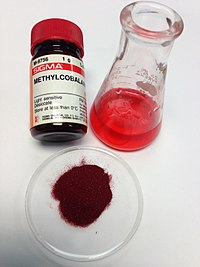Vitamin B12/ja: Difference between revisions
Created page with "メチルマロニル補酵素Aムターゼ(MUT)は、AdoB<sub>12</sub>型と反応タイプ1を用いてL-メチルマロニル-CoAをスクシニル-CoAに変換する異性化酵素であり、いくつかのアミノ酸のスクシニル-CoAへの異化分解におけるクエン酸サイクルを介してエネルギー生産に入る。重..." |
Created page with "===貯蔵と排泄=== ビタミンB<sub>12</sub>の濃度がどれくらい速く変化するかは、食事から摂取される量、分泌される量、吸収される量のバランスに左右される。体内に貯蔵されているビタミンB<sub>12</sub>の総量は、成人で約2~5{{nbsp}}mgである。その約50%は肝臓に貯蔵されている。このうち約0.1%は腸への分泌物によって1日に失われるが、これはこれらの分..." Tags: Mobile edit Mobile web edit |
||
| (5 intermediate revisions by the same user not shown) | |||
| Line 222: | Line 222: | ||
[[Methylmalonyl-CoA mutase/ja|メチルマロニル補酵素Aムターゼ]](MUT)は、AdoB<sub>12</sub>型と反応タイプ1を用いて[[L-methylmalonyl-CoA/ja|L-メチルマロニル-CoA]]を[[succinyl-CoA/ja|スクシニル-CoA]]に変換する異性化酵素であり、いくつかの[[amino acid/ja|アミノ酸]]のスクシニル-CoAへの異化分解における[[citric acid cycle/ja|クエン酸サイクル]]を介してエネルギー生産に入る。重要なステップである。この機能は[[vitamin B12 deficiency/ja|ビタミンB<sub>12</sub>欠乏症]]で失われ、臨床的には血清[[methylmalonic acid/ja|メチルマロン酸]](MMA)濃度の上昇として測定できる。MUTの機能は適切な[[myelin/ja|ミエリン]]合成に必要である。動物実験に基づくと、増加したメチルマロニル-CoAが加水分解して神経毒性のあるジカルボン酸であるメチルマロン酸(メチルマロン酸)を形成し、神経学的悪化を引き起こすと考えられている。 | [[Methylmalonyl-CoA mutase/ja|メチルマロニル補酵素Aムターゼ]](MUT)は、AdoB<sub>12</sub>型と反応タイプ1を用いて[[L-methylmalonyl-CoA/ja|L-メチルマロニル-CoA]]を[[succinyl-CoA/ja|スクシニル-CoA]]に変換する異性化酵素であり、いくつかの[[amino acid/ja|アミノ酸]]のスクシニル-CoAへの異化分解における[[citric acid cycle/ja|クエン酸サイクル]]を介してエネルギー生産に入る。重要なステップである。この機能は[[vitamin B12 deficiency/ja|ビタミンB<sub>12</sub>欠乏症]]で失われ、臨床的には血清[[methylmalonic acid/ja|メチルマロン酸]](MMA)濃度の上昇として測定できる。MUTの機能は適切な[[myelin/ja|ミエリン]]合成に必要である。動物実験に基づくと、増加したメチルマロニル-CoAが加水分解して神経毒性のあるジカルボン酸であるメチルマロン酸(メチルマロン酸)を形成し、神経学的悪化を引き起こすと考えられている。 | ||
''MTR''遺伝子によってコードされる[[Methionine synthase/ja|メチオニン合成酵素]]は、MeB<sub>12</sub>と反応型2を用いて[[5-methyltetrahydrofolate/ja|5-メチルテトラヒドロ葉酸]]から[[homocysteine/ja|ホモシステイン]]にメチル基を転移し、それによって[[tetrahydrofolate/ja|テトラヒドロ葉酸]](THF)と[[methionine/ja|メチオニン]]を生成するメチル基転移酵素である。この機能は[[vitamin B12 deficiency/ja|ビタミンB<sub>12</sub>欠乏症]]では失われ、その結果[[homocysteine/ja|ホモシステイン]]濃度が上昇し、[[folate/ja|葉酸]]が5-メチル-テトラヒドロ葉酸として捕捉され、そこからTHF(葉酸の活性型)を回収することができなくなる。THFはDNA合成において重要な役割を果たすため、THFの利用可能性が低下すると、ターンオーバーの速い細胞、特に赤血球や、吸収を担う腸管壁細胞の生産がうまくいかなくなる。THFは、MTRによって再生されることもあれば、食事中の新鮮な葉酸から得られることもある。したがって、[[pernicious anemia/ja|悪性貧血]]の[[megaloblastic anemia/ja|巨赤芽球性貧血]]を含む、B<sub>12</sub>欠乏によるDNA合成作用のすべては、十分な食事性葉酸が存在すれば解決する。したがって、B<sub>12</sub>の最もよく知られた「機能」(DNA合成、細胞分裂、貧血に関与する機能)は、実際には、B<sub>12</sub>が仲介する[[:wikt:facultative|通性]]機能であり、効率的なDNA産生に必要な活性型葉酸の保存である。他のコバラミン要求性メチルトランスフェラーゼ酵素も細菌では知られており、Me-H<sub>4</sub>-MPT、補酵素Mメチルトランスフェラーゼなどがある。 | |||
[[Methionine synthase]] | |||
==生理学== | |||
{{Anchor|Physiology}} | |||
=== | ===吸収=== | ||
ビタミンB<sub>12</sub>はB<sub>12</sub>特異的輸送タンパク質によって、または受動拡散を介して吸収される。輸送を介した吸収と組織への送達は、3つの輸送タンパク質:[[haptocorrin/ja|ハプトコリン]](HC)、[[intrinsic factor/ja|内在性因子]](IF)、[[transcobalamin II/ja|トランスコバラミンII]](TC2)とそれぞれの膜受容体タンパク質が関与する複雑なプロセスである。HCは唾液中に存在する。ビタミンを含む食物が胃に分泌された[[hydrochloric acid/ja|塩酸]]と[[pepsin/ja|ペプシン]]によって消化される際、HCはビタミンと結合し、酸による分解からビタミンを保護する。胃を出ると[[chyme/ja|消化液]]の塩酸は[[duodenum/ja|十二指腸]]で[[sodium bicarbonate/ja|重炭酸塩]]によって中和され、膵プロテアーゼはHCからビタミンを放出し、胃内の食物の存在に反応して胃[[parietal cell/ja|壁側細胞]]から分泌されるタンパク質であるIFによって結合されるようにする。IFは[[cubilin/ja|キュビリン]]と[[amnionless/ja|アムニオンレス]]という受容体タンパク質にビタミンを供給し、これらは一緒になって遠位[[ileum/ja|回腸]]の[[cubam/ja|キュバム]]受容体を形成する。この受容体はIF-B<sub>12</sub>複合体に特異的であるため、IFに結合していないビタミンは結合しない。 | |||
B<sub>12</sub>の腸管吸収に関する調査では、1回の経口投与あたりの吸収上限は約1.5{{nbsp}}μgで、効率は50%であることが確認されている。対照的に、B<sub>12</sub>吸収の受動拡散過程-通常、食物摂取によるビタミンの全吸収のごく一部-は、B<sub>12</sub>の経口投与量が非常に多い場合、ハプトコリンとIFを介した吸収を上回る可能性があり、その効率はおよそ1%である。したがって、1日あたり500~1000{{nbsp}}μgのサプリメントB<sub>12</sub>を摂取することで、[[pernicious anemia/ja|悪性貧血]]や他の特定のB<sub>12</sub>吸収障害を、根本的な吸収障害を修正することなく、B<sub>12</sub>を毎日大量に経口摂取して治療することができる。 | |||
IF/B<sub>12</sub>複合体がキュバムに結合した後、複合体は解離し、遊離ビタミンは[[portal circulation/ja|門脈循環]]に輸送される。TC2およびそのレセプターの遺伝的産生不全は、B<sub>12</sub>の機能的欠乏や小児[[megaloblastic anemia/ja|巨赤芽球性貧血]]、血中B<sub>12</sub>濃度が正常であってもB<sub>12</sub>関連生化学の異常を引き起こす。ビタミンが細胞内で機能するためには、TC2-B<sub>12</sub>複合体は細胞受容体タンパク質と結合し、[[endocytosisエンドサイトーシス]]されなければならない。TC2は[[lysosome/ja|リソソーム]]内で分解され、遊離したB<sub>12</sub>は細胞質に放出され、そこで細胞酵素によって生理活性補酵素に変換される。 | |||
====Malabsorption==== | ====Malabsorption==== | ||
[[ | 胃酸を中和する[[antacid/ja|制酸]]薬物や酸産生を阻害する薬物([[proton-pump inhibitor/ja|プロトンポンプ阻害薬]]など)は、胃での食物からの放出を妨げることにより、B<sub>12</sub>の吸収を阻害する。B12吸収不良の他の原因としては、[[intrinsic factor/ja|内因性因子]]の欠乏、[[pernicious anemia/ja|悪性貧血]]、[[bariatric surgery/ja|肥満手術]]による膵機能不全、閉塞性黄疸、熱帯スプルーおよびセリアック病、回腸遠位部の放射線性腸炎などがある。年齢も一因となりうる。高齢者は胃の胃壁細胞の機能が低下しているため、しばしば[[achlorhydria/ja|無胃酸症]]になり、B<sub>12</sub>欠乏症のリスクが高くなる。 | ||
===貯蔵と排泄=== | |||
ビタミンB<sub>12</sub>の濃度がどれくらい速く変化するかは、食事から摂取される量、分泌される量、吸収される量のバランスに左右される。体内に貯蔵されているビタミンB<sub>12</sub>の総量は、成人で約2~5{{nbsp}}mgである。その約50%は肝臓に貯蔵されている。このうち約0.1%は腸への分泌物によって1日に失われるが、これはこれらの分泌物がすべて再吸収されるわけではないからである。[[bile/ja|胆汁]]はB<sub>12</sub>排泄の主な形態である。胆汁中に分泌されたB<sub>12</sub>のほとんどは、[[enterohepatic circulation/ja|腸肝循環]]を介して再利用される。血液の結合能力を超えた過剰なB<sub>12</sub>は、通常尿中に排泄される。B<sub>12</sub>の極めて効率的な腸肝循環のおかげで、肝臓は3~5年分のビタミンB<sub>12</sub>を貯蔵することができる;したがって、このビタミンの栄養欠乏は、吸収不良障害がない成人ではまれである。腸肝再吸収がない場合、ビタミンB<sub>12</sub>は数ヶ月から1年分しか貯蔵されない。 | |||
=== 細胞の初期化=== | === 細胞の初期化=== | ||
Latest revision as of 10:56, 6 April 2024
 コバラミン類の一般的な骨格式である。 | |
 | |
| Clinical data | |
|---|---|
| Other names | Vitamin B12, vitamin B-12, cobalamin |
| AHFS/Drugs.com | Monograph |
| MedlinePlus | a605007 |
| License data |
|
| Routes of administration | 口から, 舌下, intravenous/ja (IV), intramuscular/ja (IM), 経鼻 |
| ATC code | |
| Legal status | |
| Legal status |
|
| Pharmacokinetic data | |
| Bioavailability | 回腸の遠位半分で容易に吸収される。 |
| Protein binding | 特定のトランスコバラミン血漿タンパク質への結合性が非常に高い。 ヒドロキソコバラミンの結合性はシアノコバラミンよりわずかに高い。 |
| Metabolism | Liver/ja |
| Elimination half-life | 約6日間 (肝臓では400日間) |
| Excretion | Kidney/ja |
| Identifiers | |
| |
| CAS Number | |
| PubChem CID | |
| DrugBank | |
| ChemSpider | |
| UNII | |
| KEGG | |
| ChEMBL | |
| Chemical and physical data | |
| Formula | C63H88CoN14O14P |
| Molar mass | 1355.388 g·mol−1 |
| 3D model (JSmol) | |
| |
| |
ビタミンB12は、コバラミンとしても知られ、代謝に関与する水溶性のビタミンである。8種類のビタミンB群の1つである。DNA合成の補因子として、また脂肪酸とアミノ酸代謝の両方で使用する動物に必要である。神経系ではミエリンの合成、循環器系では骨髄における赤血球の成熟に重要な役割を果たす。植物はコバラミンを必要とせず、コバラミンに依存しない酵素で反応を行う。
ビタミンB12はすべてのビタミンの中で最も化学的に複雑であり、ヒトにとっては動物由来の食品またはサプリメントから摂取しなければならない唯一のビタミンである。ビタミンB12を合成できるのは一部の古細菌とバクテリアだけである。ビタミンB12欠乏症は、特に動物性食品の消費量が少ない集団に広く見られる症状である。これは、社会経済的地位の低さ、倫理的配慮、菜食主義などのライフスタイルの選択など、さまざまな理由によるものである。
ビタミンB12を含む食品には、肉、貝、肝臓、魚、鶏肉、卵、乳製品などがある。多くの朝食用シリアルはこのビタミンで食品強化されている。ビタミンB12欠乏症の治療と予防には、サプリメントや医薬品が利用できる。通常は口から摂取するが、欠乏症の治療には筋肉注射で投与することもある。
ビタミンB12欠乏は、妊娠中、幼児、高齢者に大きな影響を及ぼし、栄養失調のために中低開発国でより一般的である。先進国におけるビタミンB12欠乏の最も一般的な原因は、吸収が起こるためには食物由来のB12と結合していなければならない胃内在因子(IF)の損失による吸収障害である。第二の主な原因は、加齢に伴う胃酸産生の低下である(無胃酸症)。同じ理由で、プロトンポンプ阻害薬やH2遮断薬などの制酸剤を長期間使用している人はリスクが高くなる。
ベジタリアンや菜食主義者の食事では、栄養補助食品を摂取しない限り、十分なB12を摂取できないことがある。欠乏症は、手足の神経障害や、悪性貧血と呼ばれる血液疾患、赤血球が異常に大きくなる|貧血の一種と呼ばれる血液疾患によって特徴づけられることがある。その結果、疲労感、思考力の低下、ふらつき、息切れ、頻繁な感染症、食欲不振、手足の知覚異常、抑うつ、記憶喪失、錯乱、歩行困難、optic neuropathy/ja視神経障害、不可逆的な神経損傷、その他多くの症状が現れる。乳児の場合、欠乏を放置すると神経障害や貧血を引き起こす可能性がある。個体内の葉酸濃度は、ビタミンB12欠乏症の病理学的変化や症状の経過に影響を及ぼす可能性がある。妊婦におけるビタミンB12欠乏は、自然流産、神経管欠損症などの先天奇形、胎児の脳発達成長障害などのリスク上昇と強く関連している。
ビタミンB12は、ビタミンB12の欠乏により、血液中の赤血球の数が通常より少なくなる自己免疫疾患である悪性貧血の結果として発見された。ビタミンを吸収する能力は加齢とともに、特に60歳以上では低下する。
定義
ビタミンB12はコバルトの配位錯体で、コリン配位子の中心を占め、さらにベンズイミダゾール配位子とアデノシル基が結合している。多くの近縁種が知られており、これらは同様の挙動を示し、特にすべてがビタミンとして機能する。この化合物群は「コバラミン」と呼ばれることもある。これらの化合物は類似した分子構造を持ち、それぞれがビタミン欠乏の生体系でビタミン活性を示すことから、ビタマーと呼ばれる。ビタミンの活性は補酵素としてのもので、酵素触媒反応にその存在が必要であることを意味する。
- アデノシルコバラミン
- シアノコバラミンは、ビタミンB12のアデノシル配位子がシアン化物で置換されている。
- ヒドロキソコバラミンは、ビタミンB12のアデノシル配位子を水酸化物に置き換えたものである。
- ビタミンB12のアデノシル配位子はメチルで置換される。
シアノコバラミンは、B12の製造形態である。細菌発酵によってAdoB12とMeB12が生成され、亜硝酸ナトリウムと熱の存在下で青酸カリを加えることによってシアノコバラミンに変換される。シアノコバラミンが消費されると、生物学的に活性なAdoB12とMeB12に変換される。ビタミンB
12の2つの生理活性型は、サイトゾル中のメチルコバラミンとミトコンドリア中のアデノシルコバラミンである。
シアノコバラミンが栄養補助食品や食品強化に最もよく使われるのは、シアンが分解に対して分子を安定させるからである。メチルコバラミンも栄養補助食品として提供されている。ビタミンB12欠乏症の治療にアデノシルコバラミンやメチルコバラミン型を使用する利点はない。
ヒドロキソコバラミンは、ビタミンB12欠乏症を治療するために筋肉内に注射することができる。ヒドロキシル基がシアン化物によって置換され、尿中に排泄される無毒のシアノコバラミンが生成されるため、シアン化物中毒を治療する目的で静脈注射することもできる。
"疑似ビタミンB12"は、ビタミンに似た構造を持つがビタミン活性を持たないコリノイドである化合物を指す。偽ビタミンB12は、藻類の健康食品であるスピルリナに含まれるコリノイドの大部分である。
欠乏症
ビタミンB12欠乏症は、特に脳と神経系に深刻で不可逆的な損傷を引き起こす可能性がある。正常値よりわずかに低いレベルで欠乏すると、疲労、脱力感、ふらつき、めまい、息苦しさ、頭痛、口内炎、胃のむかつき、食欲低下などのさまざまな症状を引き起こす可能性がある、 歩行困難(ふらつきバランス障害)、筋力低下、抑うつ、記憶力低下、反射神経低下、錯乱、皮膚の青白さ、知覚異常など、特に60歳以上の人に多い。ビタミンB12欠乏症はまた、躁病や精神病の症状を引き起こすこともある。
ビタミンB12欠乏性貧血の主なタイプは悪性貧血であり、症状の三徴候を特徴とする:
- 骨髄前赤芽球癆を伴う貧血(巨赤芽球性貧血)。これはDNA合成(特にプリンとチミジン)の阻害によるものである。
- 消化器症状:軽度の下痢や便秘などの腸管運動の変化、膀胱や腸のコントロールができなくなる。これらは、細胞の入れ替わりが激しい組織部位において、DNA合成の欠陥が複製を阻害するためと考えられている。これは、悪性貧血における胃の壁細胞に対する自己免疫攻撃にも起因している可能性がある。胃前庭血管拡張症(スイカ胃と呼ばれることもある)と悪性貧血との関連がある。
- 神経学的症状:感覚または運動障害(反射の欠如、振動または軟部触覚の減退)および亜急性脊髄複合変性症がある。小児における欠損症状には、発達遅延、退行、過敏性、不随意運動、および筋緊張低下が含まれる。
ビタミンB12欠乏症は、最も一般的には吸収不良によって起こるが、摂取量の低下、免疫性胃炎、結合タンパク質の存在低下、特定の医薬品の使用によっても起こる。植物性食品にはビタミン欠乏症を予防するのに十分な量のビタミンが含まれていないため、菜食主義者-動物性食品を一切摂取しないことを選択した人々-にはリスクがある。また、菜食主義者-乳製品や卵などの動物性副産物は摂取するが、動物の肉は摂取しない-もリスクがある。ビタミンB12欠乏症は、ビタミンB12サプリメントを摂取していないか、ビタミン強化食品を摂取していないベジタリアン人口の40%から80%で観察されている。香港とインドでは、菜食主義者の約80%にビタミンB12欠乏症が認められている。ベジタリアンと同様に、菜食主義者も栄養補助食品を摂取するか、シリアル、植物性ミルク、栄養酵母などのビタミンB12強化食品を常食することでこれを避けることができる。高齢者は、加齢とともに胃酸の分泌が減少する傾向があり、無胃酸症として知られる状態になるため、リスクが高くなる。
亜酸化窒素の過剰摂取や過剰使用は、ビタミンB12の活性な一価型を不活性な二価型に変換する。
妊娠期、授乳期、幼児期
米国の推奨食事許容量 (RDA)は、妊娠期は2.6 μg/d、授乳期は2.8 µg/日である。これらの値の決定は、非妊娠女性のRDATemplate:値に、妊娠中に胎児に移行する分と母乳中に移行する分を加えたものである。しかし、同じ科学的根拠から、欧州食品安全機関(EFSA)は適切摂取量(AI)を、妊娠期は4.5 μg/d、授乳期は5.0 μg/dとしている。妊娠中、胎盤はB12を濃縮するので、新生児の血清濃度は母親よりも高くなる。より効果的に胎盤に到達するのは最近吸収されたビタミンであるため、母親になる女性が摂取するビタミンは、肝臓組織に含まれるビタミンよりも重要である。
動物性食品をほとんど摂取していない女性、あるいはベジタリアンやビーガンの女性は、動物性食品を多く摂取している女性よりも、妊娠中にビタミン欠乏症になるリスクが高い。この欠乏は貧血を引き起こし、母乳で育てられた乳児がビタミン欠乏症になるリスクも高くなる。ビタミンB12は、世界保健機関(WHO)が妊娠中の健康な女性に推奨するサプリメントのひとつではないが、特にベジタリアンやビーガンの食生活を送っている妊娠中の母親には、葉酸と一緒にマルチビタミンにビタミンB12を配合することがよく勧められている。
母乳中のビタミン濃度が低いのは、社会経済的地位が低いか、動物性食品の消費量が少ない家庭である。小麦粉やトウモロコシ粉の食品強化プログラムが義務づけられているのは、アフリカを中心とした数カ国だけで、インドには任意の強化プログラムがある。授乳中の母親が摂取するものは、肝組織の含有量よりも、最近吸収されたビタミンがより効果的に母乳に到達することの方が重要である。母乳中のビタミンB12は、栄養状態の良い母親でもビタミン欠乏症の母親でも、授乳期間中に減少する。6ヵ月を超える母乳育児は、授乳中の乳児の血清ビタミン状態が低いことを示す強い指標となる。特に、妊娠中にビタミン状態が不良であった場合や、母乳育児中の乳児に与える初期導入食品がビーガンであった場合に当てはまる。
離乳後の食事に動物性食品が少ないと、欠乏症のリスクは続く。乳幼児のビタミン低下には、貧血、発育不良、神経発達の遅れなどがある。血清B12が低値と診断された子どもは、筋肉注射で治療した後、経口栄養補助食品に移行することができる。
胃バイパス手術
病的肥満の治療には、さまざまな胃バイパス手術や胃制限手術が行われている。ルークス-エン-Y胃バイパス手術(RYGB)ではビタミンB12欠乏症のリスクが高まるが、スリーブ胃バイパス手術や胃バンディング手術ではビタミンB12欠乏症のリスクは高まらない。術後の経口補給では、ビタミン欠乏症を予防するために1000 μg/dが必要となることがある。
診断
ある総説によれば 現在のところ、ビタミンB12欠乏症の診断のための "ゴールドスタンダード"となる検査は存在しない。ビタミン欠乏症は、通常、ルーチンの全血球計算で平均赤血球量(MCV)の上昇を伴う貧血が認められた場合に疑われる。また、末梢血塗抹標本では、巨赤芽球や過分化した多形核白血球がみられることがある。診断は、ビタミンB12の血中濃度が成人で150~180pmol/L(200~250pg/mL)未満であることに基づく。しかし、組織のB12貯蔵量が枯渇しつつある一方で、血清値は維持できる。したがって、欠乏のカットオフポイントを超える血清B12値は、必ずしも十分なB12の状態を確認するものではない。このため、血中B12濃度だけに頼るよりも、血清ホモシステインが15μmol/L以上、メチルマロン酸(MMA)が0.271μmol/L以上上昇している方が、B12欠乏の指標として優れていると考えられている。しかし、MMAの上昇はB12欠乏症の人だけでなく、腎不全のある高齢者にも見られるため決定的なものではなく、ホモシステインの上昇は葉酸欠乏症の人にも見られるため決定的なものではない。さらに、メチルマロン酸値の上昇は、メチルマロン酸血症などの代謝障害に関連している可能性もある。神経系の障害があり、血液検査で結論が出ない場合は、腰椎穿刺を行って脳脊髄液を測定することがある。B12値を測定する。
血清ハプトコリンは循環B12の80-90%と結合し、トランスコバラミンIIによる細胞内運搬が不可能になる。これは循環貯蔵機能であると推測されている。生命を脅かすような重篤な疾患の中には、血清ビタミンB12が異常に高いために血清HCが上昇するものがあるが、同時にビタミンを細胞に運搬するトランスコバラミンIIに結合するビタミンが不十分であるために、症状のあるビタミン欠乏症として現れる可能性がある。
医療用途

欠乏症の治療
重度のビタミンB12欠乏症は、まず1000 μgの毎日の筋肉内注射で改善され、その後、毎月同量の注射または1000 μgの毎日の経口投与で維持される。通常のトランスポータータンパク質を介した吸収がなく、非常に非効率的な腸管受動吸収しか残らないため、1日の投与量はビタミンの必要量をはるかに超える。注射の副作用には、皮膚の発疹、かゆみ、悪寒、発熱、ほてり、吐き気、めまいなどがある。経口維持療法はこの問題を回避し、治療費を大幅に削減する。
シアン中毒
シアン化合物中毒に対しては、大量のヒドロキソコバラミンが静脈内に投与されることがあり、時にはチオ硫酸ナトリウムと併用されることもある。
食事に関する推奨事項
アメリカやイギリスでは、ほとんどの人が十分なビタミンB12を摂取しているという調査結果もある。しかし、他の研究によると、ビタミンB12が低いか、あるいは限界レベルである人の割合は、西洋世界では40%にも達する。穀物ベースの食品は、ビタミンを添加することによって強化することができる。ビタミンB12のサプリメントは、単一または複数のビタミン錠剤として入手可能である。ビタミンB12の医薬品製剤は、筋肉注射で投与することができる。動物性以外のビタミン源はほとんどないため、菜食主義者はB12摂取のために栄養補助食品や強化食品を摂取するか、深刻な健康被害を被るリスクを負うことを勧められる。発展途上国のある地域の子供たちは、動物性食品の少ない食事と相まって成長期に必要量が増加するため、特に危険である。
米国医学アカデミーは1998年にビタミンB12の推定平均必要量(EAR)と推奨食事許容量(RDA)を更新した。14歳以上の女性と男性のビタミンB12のEARは2.0 μg/日であり、RDAは2.4 μg/日である。RDAはEARより高いが、これは平均より必要量の多い人をカバーする量を特定するためである。妊娠中のRDAは2.6 μg/dayである。授乳期のRDAは2.8 μg/dに等しい。12ヵ月までの乳児の場合、適切な摂取量(AI)は0.4~0.5 μg/dayである(AIは、EARとRDAを決定するのに十分な情報がない場合に設定される)。1~13歳の子供の場合、RDAは年齢とともに0.9~1.8 μg/dayと増加する。高齢者の10~30%は食品に含まれるビタミンB12を効果的に吸収できない可能性があるため、50歳以上の高齢者は主にビタミンB12を強化した食品やビタミンB12を含むサプリメントを摂取することでRDAを満たすことが望ましい。安全性に関しては、十分なエビデンスがある場合には、ビタミンやミネラルについて耐容上限摂取量(ULと呼ばれる)が設定されている。ビタミンB12の場合、高用量摂取による有害作用に関するヒトでのデータがないため、ULは設定されていない。EAR、RDA、AI、ULを総称して食事摂取基準量(DRI)と呼ぶ。
欧州食品安全機関(EFSA)は、RDAの代わりに人口基準摂取量(PRI)、EARの代わりに平均必要量を用いて、一連の情報の集合体を「食事摂取基準値」と呼んでいる。AIとULは、EFSAによって米国と同じように定義されている。18歳以上の女性と男性については、十分摂取量(AI)は4.0 μg/日とされている。妊娠中のAIは4.5μg/日、授乳期は5.0 μg/日である。1~14歳の小児については、年齢とともにAIは1.5~3.5 μg/日と増加する。これらの基準値は米国のRDAよりも高い。EFSAは安全性についても検討し、ビタミンB12のULを設定するには十分な証拠がないという、米国と同じ結論に達した。
国立健康・栄養研究所は、12歳以上の推奨摂取量を2.4 μg/日と定めている。また、世界保健機関(WHO)もこのビタミンの成人推奨栄養摂取量として2.4 μg/日を用いている。
米国の食品および栄養補助食品の表示目的では、1食あたりの量は「1日当たりの価値の割合」(%DV)で表される。ビタミンB12の表示目的では、1日価値の100%は6.0 μgであったが、2016年5月27日に2.4 μgに下方修正された。更新された表示規制への適合は、年間食品売上高がUS$10 百万ドル以上の製造業者については2020年1月1日までに、それ以下の製造業者については2021年1月1日までに義務付けられた。新旧の成人一日摂取量の表は基準一日摂取量に掲載されている。
摂取源
バクテリアと古細菌
ビタミンB12は、自然界では特定の細菌と古細菌によって産生される。ヒトや他の動物では腸内細菌叢の一部の細菌によって合成されるが、ほとんどの栄養素の吸収が行われる小腸の下流にある大腸で作られるため、ヒトはこれを吸収できないと長い間考えられてきた。ウシやヒツジなどの反芻動物は前腸発酵動物であり、植物性食物は真の胃(アボマサム)に入る前にルーメンで微生物発酵を受けるため、細菌によって産生されたビタミンB12を吸収している。
他の哺乳類種(例:ウサギ、ナキウサギ、ビーバー、モルモット)は高繊維質の植物を摂取し、消化管を通過して盲腸と大腸で細菌発酵を受ける。この後腸発酵において、盲腸からの物質は「ネコトロープ」として排出され、再摂取される、この行為は|子嚢菌と呼ばれる。再摂取によって、細菌発酵によって利用可能になった栄養素や、ビタミンB12を含む腸内細菌によって合成されたビタミンやその他の栄養素の吸収が可能になる。
反芻動物ではない、後腸を持たない草食動物は、細菌発酵とビタミンB12を含むビタミンB生産のための場所を提供するために、肥大した森林胃および/または小腸を持っているかもしれない。腸内細菌がビタミンB12を生産するためには、動物は十分な量のコバルトを摂取しなければならない。コバルトが欠乏した土壌ではビタミンB12が欠乏する可能性があり、家畜にはビタミンB12の注射やコバルトの補給が必要になる。
動物由来の食品
動物は食事から摂取したビタミンB12を肝臓や筋肉に蓄え、そのビタミンを卵や牛乳に取り込むものもある。したがって、肉、レバー、卵、牛乳は、人間を含む他の動物にとってのビタミン源である。昆虫は動物(他の昆虫や人間を含む)にとってB12の供給源である。ビタミンB12を多く含む動物由来の食品源としては、レバーや、羊肉、子牛肉、牛肉、七面鳥などの内臓肉、また貝類やカニ肉などがある。
植物と藻類
植物性食品のバクテリアによる発酵や藻類とバクテリアの共生関係によってビタミンB12が摂取できるという証拠がいくつかある。しかし、栄養・食事療法学会は植物や藻類からの摂取は「信頼できない」と考えており、代わりにビーガンは強化食品やサプリメントに頼るべきだと述べている。
ビタミンB12の天然植物および藻類の供給源としては、テンペなどの醗酵植物食品や、海苔や海苔パンなどの海藻由来の食品がある。メチルコバラミンはクロレラ・ブルガリスから確認されている。ビタミンB12を合成するのに必要な遺伝子と酵素を持っているのは細菌と一部のアルケアだけであるため、植物や藻類の供給源はすべて、様々な種類の細菌との共生から、あるいは植物発酵食品の場合は細菌発酵から、二次的にビタミンを得ている。
強化食品
ビタミンB12強化食品が販売されている食品には、朝食用シリアル、豆乳やオートミールなどの植物由来の代用乳、エナジーバー、栄養酵母などがある。強化成分はシアノコバラミンである。微生物発酵によりアデノシルコバラミンが生成され、亜硝酸ナトリウムと熱の存在下、シアン化カリウムまたはチオシアン酸塩の添加によりシアノコバラミンに変換される。
2019年現在、19カ国が小麦粉、トウモロコシ粉、米にビタミンB12を強化することを義務付けている。そのほとんどはアフリカ南東部か中央アメリカにある。
ヴィーガンを擁護する団体などは、すべてのヴィーガンにB12を強化食品かサプリメントから摂取することを推奨している。
サプリメント

ビタミンB12は、マルチビタミンの錠剤に含まれている。パンやパスタなどの穀物ベースの食品にB12が強化されている国もある。米国では、非処方箋の製品を購入することができ、それぞれ最大5,000 μgを提供し、エナジードリンクやエナジーショットの一般的な成分であり、通常、B12の推奨食事摂取量の何倍もある。また、ビタミンは処方箋によって供給され、注射やその他の手段で投与されることもある。
シアン化物を含まない舌下投与メチルコバラミンは、5 mgの錠剤で入手できる。メチルコバラミンの代謝運命と生物学的分布は、食事中のビタミンB12の他の供給源と同様であると予想される。シアノコバラミンに含まれるシアンの量(1,000 µgのシアノコバラミン錠剤で20 µg)は、食品からのシアンの1日の消費量よりも少ないため、シアノコバラミンが健康リスクになるとは考えられていない。
ヒドロキシコバラミンの注射
ヒドロキシコバラミンの注射は消化吸収が悪い場合によく行われるが、高用量の経口サプリメント(0.5-1.0 mg以上など)では、この方法は必要ないかもしれない。なぜなら、経口で大量に摂取したビタミンでは、受動拡散によって腸全体に沿って吸収される遊離結晶B12の1%~5%でも、必要量は十分だからである。
コバラミンC病(メチルマロン酸尿症とホモシスチン尿症を併発する)の患者には、ヒドロキソコバラミンまたは経皮B12の静脈内投与または筋肉内投与による治療が必要な場合がある。
ビタミンB12の補給に使われるナノテクノロジー
従来の投与法では、ビタミンB12の特異的な分布と制御された放出は保証されていない。さらに、注射を伴う治療プロトコールは、医療従事者や患者の通院を必要とするため、治療費が増大し、患者のライフスタイルを損なうことになる。ビタミンB12の標的への送達は、現代の処方の主要な焦点である。例えば、ビタミンを骨髄や神経細胞に運ぶことは、ミエリンの回復を助けることになる。現在、ビタミンB12の送達を改善するために、いくつかのナノキャリア戦略が開発されており、投与の簡素化、コストの削減、薬物動態の改善、患者の生活の質の向上を目指している。
擬似ビタミンB12
擬似ビタミンB12とは、ヒトでは生物学的に不活性なB12様類似物質を指す。スピルリナを含むほとんどの藍藻類や、ポルフィラテネラ(日本では海苔と呼ばれる海藻食品に使用される)などの一部の藻類には、生物学的に活性なB12の代わりに擬似ビタミンB12が多く含まれていることが分かっている。これらの擬似ビタミン化合物は、ある種の貝類や食用昆虫に含まれ、時には栄養補助食品や強化食品に添加されるシアノコバラミンの代謝分解産物として発見されることもある。
擬似ビタミンB12は、Lactobacillus delbrueckii subsp. lactisを用いた微生物学的アッセイを行うと、生物学的に活性なビタミンB12として表示されることがある。B12含量の信頼できる測定値を得るためには、より高度な技術が利用できる。そのような技術のひとつに、シリカゲルによる前分離と、B12依存性の大腸菌による評価がある。
関連する概念として抗ビタミンがある。B12は、ビタミン作用を持たないだけでなく、真のビタミンB12の活性を積極的に妨害する化合物(しばしば合成B12類似体)である。これらの化合物の設計には、主に金属イオンをロジウム、ニッケル、亜鉛で置き換えたり、4-エチルフェニルのような不活性な配位子をつけたりすることが含まれる。これらの化合物は、B12の利用経路を分析したり、B12依存性の病原体を攻撃したりするのにも使える可能性がある。
薬物相互作用
H2受容体拮抗薬とプロトンポンプ阻害薬
吸収のためにタンパク質からビタミンB12を放出するには胃酸が必要である。H2遮断薬やプロトンポンプ阻害薬(PPI)薬物の使用による胃酸とペプシンの分泌の減少は、サプリメントのビタミンB12ではないが、タンパク質と結合した(食事性)ビタミンB12の吸収を低下させる可能性がある。H2受容体拮抗薬の例としては、シメチジン、ファモチジン、ニザチジン、ラニチジンなどがある。PPIの例としては、オメプラゾール、ランソプラゾール、ラベプラゾール、パントプラゾール、エソメプラゾールが挙げられる。臨床的に重大なビタミンB12欠乏症や巨赤芽球性貧血が起こる可能性は、これらの薬物療法が2年以上長期にわたる場合や、食事からの摂取量が推奨値を下回る場合を除き、ほとんどない。症候性ビタミン欠乏症は、無胃酸症(胃酸分泌が完全にない状態)になった場合に起こりやすく、これはH2遮断薬よりもプロトンポンプ阻害薬でより頻繁に起こる。
メトホルミン
ビタミンB12の血清中濃度の低下は、抗糖尿病薬メトホルミンを長期服用している人の最大30%にみられる。食事によるビタミンB12の摂取が十分であるか、予防的にビタミンB12を補給していれば、欠乏症は発症しない。欠乏症が発見された場合は、B12サプリメントで欠乏症を改善する間、メトホルミンを継続することができる。
他の薬物
コルヒチン、徐放性カリウム製剤、ゲンタマイシン、ネオマイシン、トブラマイシンなどの抗生物質など、経口摂取したビタミンB12の吸収を低下させる医薬品がある。抗痙攣薬であるフェノバルビタール、プレガバリン、プリミドン、トピラマートは血清ビタミン濃度が正常値より低いことと関連している。しかし、バルプロ酸塩を処方された患者では血清中のビタミン濃度が高かった。さらに、アモキシシリン、エリスロマイシン、メトトレキサート、ピリメタミンなど、特定の薬物はビタミンの臨床検査を妨害することがある。
化学

ビタミンB12は、すべてのビタミンの中で最も化学的に複雑である。B12の構造は、ヘムに見られるポルフィリン環に似たコリン環に基づいている。中心金属イオンはコバルトである。 空気中で安定な固体として単離され、市販されているビタミンB12(シアノコバラミンと他のビタマー)に含まれるコバルトは+3酸化状態で存在する。 生化学的には、コバルトの中心は、「還元型」(B12r、+2酸化状態)および「超還元型」(B12s、+1酸化状態)の形態にアクセスするために、2電子および1電子の還元過程に参加することができる。 ビタミンB12は、デオキシアデノシルラジカルの供与体(ラジカルアルキル源)として、またメチルカチオン等価体(求電子アルキル源)として働くことができる。
6つの配位部位のうち4つはコリン環、5つ目はジメチルベンズイミダゾール基である。6番目の配位部位である反応中心は可変であり、シアノ基(-CN)、ヒドロキシル基(-OH)、メチル基(-CH3)または5′-デオキシアデノシル基である。 歴史的には、炭素-コバルトの共有結合は、生物学で発見された炭素-金属結合の最初の例のひとつである。ヒドロゲナーゼや、必然的にコバルト利用に関連する酵素は、金属-炭素結合を伴う。動物はシアノコバラミンとヒドロキソコバラミンを、シアノ基またはヒドロキシル基を酵素的に置換することによって、生理活性体であるアデノシルコバラミンとメチルコバラミンに変換する能力を持っている。

食品中のビタミンB12の分析方法
食品中のビタミンB12含量の測定には、微生物学的測定法、化学発光測定法、ポーラログラフィー法、分光光度法、高速液体クロマトグラフィー法など、いくつかの方法が用いられてきた。微生物学的アッセイ法は、ビタミンB12を必要とする微生物、例えばLactobacillus delbrueckii subsp. lactis ATCC7830である。しかし、ビタミンB12の測定の不確かさが高いため、もはや基準法ではない。
さらに、この測定法では一晩のインキュベーションが必要であり、食品中に不活性なビタミンB12類似体が存在すると誤った結果が出る可能性がある。現在、食品中のビタミンB12含量の測定には、標識ビタミンB12を用いた放射性同位元素希釈法(RIDA)と豚IF(豚)が用いられている。これまでの報告では、RIDA法は微生物学的測定法と比較して、食品中のビタミンB12をより高濃度で検出できることが示唆されている。
生化学
補酵素としての機能
ビタミンB12は補酵素として機能し、いくつかの酵素触媒反応においてその存在が必要であることを意味する。動物において)機能するためにB12を必要とすることがある3つのクラスの酵素をここに挙げる:
- 異性化酵素
- 水素原子が隣接する2つの原子の間を直接移動し、それに伴って2番目の置換基X(置換基を持つ炭素原子、アルコールの酸素原子、またはアミン)が交換される転位。これらはビタミンのadoB12(アデノシルコバラミン)型を使用する。
- メチルトランスフェラーゼ群
- 2つの分子間でメチル(-CH3)基を転移する。これらはビタミンのMeB12(メチルコバラミン)型を用いる。
- 脱ハロゲナーゼである。
- 嫌気性細菌の中にはB12依存性の脱ハロゲナーゼを合成する種があり、塩素系汚染物質の分解に応用できる可能性がある。この微生物はde novoコリノイド生合成が可能であるか、外因性ビタミンB12に依存している。
ヒトでは、最初の2種類の反応に対応する2つの主要な補酵素B12依存性酵素ファミリーが知られている。これらは以下の2つの酵素に代表される:

メチルマロニル補酵素Aムターゼ(MUT)は、AdoB12型と反応タイプ1を用いてL-メチルマロニル-CoAをスクシニル-CoAに変換する異性化酵素であり、いくつかのアミノ酸のスクシニル-CoAへの異化分解におけるクエン酸サイクルを介してエネルギー生産に入る。重要なステップである。この機能はビタミンB12欠乏症で失われ、臨床的には血清メチルマロン酸(MMA)濃度の上昇として測定できる。MUTの機能は適切なミエリン合成に必要である。動物実験に基づくと、増加したメチルマロニル-CoAが加水分解して神経毒性のあるジカルボン酸であるメチルマロン酸(メチルマロン酸)を形成し、神経学的悪化を引き起こすと考えられている。
MTR遺伝子によってコードされるメチオニン合成酵素は、MeB12と反応型2を用いて5-メチルテトラヒドロ葉酸からホモシステインにメチル基を転移し、それによってテトラヒドロ葉酸(THF)とメチオニンを生成するメチル基転移酵素である。この機能はビタミンB12欠乏症では失われ、その結果ホモシステイン濃度が上昇し、葉酸が5-メチル-テトラヒドロ葉酸として捕捉され、そこからTHF(葉酸の活性型)を回収することができなくなる。THFはDNA合成において重要な役割を果たすため、THFの利用可能性が低下すると、ターンオーバーの速い細胞、特に赤血球や、吸収を担う腸管壁細胞の生産がうまくいかなくなる。THFは、MTRによって再生されることもあれば、食事中の新鮮な葉酸から得られることもある。したがって、悪性貧血の巨赤芽球性貧血を含む、B12欠乏によるDNA合成作用のすべては、十分な食事性葉酸が存在すれば解決する。したがって、B12の最もよく知られた「機能」(DNA合成、細胞分裂、貧血に関与する機能)は、実際には、B12が仲介する通性機能であり、効率的なDNA産生に必要な活性型葉酸の保存である。他のコバラミン要求性メチルトランスフェラーゼ酵素も細菌では知られており、Me-H4-MPT、補酵素Mメチルトランスフェラーゼなどがある。
生理学
吸収
ビタミンB12はB12特異的輸送タンパク質によって、または受動拡散を介して吸収される。輸送を介した吸収と組織への送達は、3つの輸送タンパク質:ハプトコリン(HC)、内在性因子(IF)、トランスコバラミンII(TC2)とそれぞれの膜受容体タンパク質が関与する複雑なプロセスである。HCは唾液中に存在する。ビタミンを含む食物が胃に分泌された塩酸とペプシンによって消化される際、HCはビタミンと結合し、酸による分解からビタミンを保護する。胃を出ると消化液の塩酸は十二指腸で重炭酸塩によって中和され、膵プロテアーゼはHCからビタミンを放出し、胃内の食物の存在に反応して胃壁側細胞から分泌されるタンパク質であるIFによって結合されるようにする。IFはキュビリンとアムニオンレスという受容体タンパク質にビタミンを供給し、これらは一緒になって遠位回腸のキュバム受容体を形成する。この受容体はIF-B12複合体に特異的であるため、IFに結合していないビタミンは結合しない。
B12の腸管吸収に関する調査では、1回の経口投与あたりの吸収上限は約1.5 μgで、効率は50%であることが確認されている。対照的に、B12吸収の受動拡散過程-通常、食物摂取によるビタミンの全吸収のごく一部-は、B12の経口投与量が非常に多い場合、ハプトコリンとIFを介した吸収を上回る可能性があり、その効率はおよそ1%である。したがって、1日あたり500~1000 μgのサプリメントB12を摂取することで、悪性貧血や他の特定のB12吸収障害を、根本的な吸収障害を修正することなく、B12を毎日大量に経口摂取して治療することができる。
IF/B12複合体がキュバムに結合した後、複合体は解離し、遊離ビタミンは門脈循環に輸送される。TC2およびそのレセプターの遺伝的産生不全は、B12の機能的欠乏や小児巨赤芽球性貧血、血中B12濃度が正常であってもB12関連生化学の異常を引き起こす。ビタミンが細胞内で機能するためには、TC2-B12複合体は細胞受容体タンパク質と結合し、endocytosisエンドサイトーシスされなければならない。TC2はリソソーム内で分解され、遊離したB12は細胞質に放出され、そこで細胞酵素によって生理活性補酵素に変換される。
Malabsorption
胃酸を中和する制酸薬物や酸産生を阻害する薬物(プロトンポンプ阻害薬など)は、胃での食物からの放出を妨げることにより、B12の吸収を阻害する。B12吸収不良の他の原因としては、内因性因子の欠乏、悪性貧血、肥満手術による膵機能不全、閉塞性黄疸、熱帯スプルーおよびセリアック病、回腸遠位部の放射線性腸炎などがある。年齢も一因となりうる。高齢者は胃の胃壁細胞の機能が低下しているため、しばしば無胃酸症になり、B12欠乏症のリスクが高くなる。
貯蔵と排泄
ビタミンB12の濃度がどれくらい速く変化するかは、食事から摂取される量、分泌される量、吸収される量のバランスに左右される。体内に貯蔵されているビタミンB12の総量は、成人で約2~5 mgである。その約50%は肝臓に貯蔵されている。このうち約0.1%は腸への分泌物によって1日に失われるが、これはこれらの分泌物がすべて再吸収されるわけではないからである。胆汁はB12排泄の主な形態である。胆汁中に分泌されたB12のほとんどは、腸肝循環を介して再利用される。血液の結合能力を超えた過剰なB12は、通常尿中に排泄される。B12の極めて効率的な腸肝循環のおかげで、肝臓は3~5年分のビタミンB12を貯蔵することができる;したがって、このビタミンの栄養欠乏は、吸収不良障害がない成人ではまれである。腸肝再吸収がない場合、ビタミンB12は数ヶ月から1年分しか貯蔵されない。
細胞の初期化
ビタミンB12は、一炭素代謝への関与を通じて、細胞初期化や組織再生、エピジェネティック制御に重要な役割を果たしている。細胞初期化とは、体細胞を多能性状態に変換するプロセスである。ビタミンB12の濃度は、ヒストン修飾H3K36me3に影響を与え、遺伝子プロモーター外での不正な転写を抑制する。生体内で初期化を行っているマウスは、B12が枯渇し、メチオニン飢餓の徴候を示すことがわかった。一方、初期化マウスと細胞にB12を補充すると、初期化効率が上昇し、細胞内在性の効果があることが示された。
合成
生合成
ビタミンB12は、ポルホビリノーゲンとヒドロキシメチルビランを介してアミノレブリン酸をウロポルフィリノーゲンIIIに変換する酵素デアミナーゼとコシンテターゼによって作られるテトラピロール構造骨格に由来する。後者はヘム、クロロフィル、シロヘムおよびB12そのものに共通する最初のマクロ環状中間体である。後の段階、特にその構造の付加的なメチル基の組み込みは、13C メチル標識S-アデノシルメチオニンを用いて研究された。。ビタミンの生合成に関与する8つの遺伝子が過剰発現されたシュードモナス・デニトリフィカンスの遺伝子操作株が使用されるまでは、メチル化および他のステップの完全な配列が決定されることはなかった。
以下の属の種および以下の個体がB12を合成することが知られている: プロピオニバクテリウム シャーマニー, シュードモナス 脱窒素菌, ストレプトマイセス グリセウス, アセトバクテリウム, アエロバクテリウム, アグロバクテリウム, アルカリゲネス, アゾトバクター, バチルス, クロストリジウム, コリネバクテリウム, フラボバクテリウム, ラクトバチルス, ミクロモノスポラ, マイコバクテリウム, ノカルジア, プロテウス, リゾビウム, サルモネラ, セラチア, 連鎖球菌, キサントモナス
工業用
ビタミンB12の工業的生産は、選ばれた微生物の発酵によって達成される。かつて真菌であると考えられていたストレプトマイセス・グリセウスは、長年ビタミンB12の商業的供給源であった。今日では、Pseudomonas denitrificans'とPropionibacterium freudenreichii'の亜種shermaniiがより一般的に使用されている。これらは収量を高めるために特別な条件下で栽培される。Rhone-Poulenc社はP. denitrificansを遺伝子操作することで収量を向上させた。プロピオニバクテリウムは、外毒素や内毒素を産生せず、アメリカの食品医薬品局から一般に安全と認められている(GRASステータスを付与されている)。
2008年のビタミンB12の世界総生産量は35,000 kg(77,175 ポンド)であった。
研究室
実験室での完全なB12の合成は1972年にロバート・バーンズ・ウッドワードとアルバート・エッシェンモーザーによって達成された。この仕事には、19カ国から91人の博士研究員(ほとんどがハーバード大学)と12人の博士課程の学生(チューリッヒ工科大学)が参加した。研究グループは既知の中間体であるコバリン酸を調製しただけであり、そのビタミンB12への化学変換は以前に報告されている。ビタミンB12のこの合成は、72の化学的工程を要し、全体の化学的収率が0.01%をはるかに下回るという長さのため、実用上の意味はない。1972年以来、散発的な合成の努力はあったが、Eschenmoser-Woodward合成は、完成された(正式な)唯一の全合成である。
歴史
欠乏症の記述
1849年から1887年にかけて、トーマス・アジソンが悪性貧血の症例を記述し、ウィリアム・オスラーとウィリアム・ガードナーが神経障害の症例を最初に記述し、ヘイムがこの病態における末梢血中の大きな赤血球について記述した、 彼はこれを「巨赤芽球」(現在では巨赤芽球と呼ぶ)と呼び、Paul Ehrlichは骨髄中の巨赤芽球を同定し、Ludwig Lichtheimは脊髄症の症例を記載した。
抗貧血食品としてのレバーの同定
1920年代、George Whippleは、生のレバーを大量に摂取することが、犬の失血性貧血を最も速やかに治癒させるようであることを発見し、レバーを食べることが悪性貧血を治療するかもしれないという仮説を立てた。エドウィン・コーンは、悪性貧血の治療に天然の肝臓製品の50倍から100倍の効力がある肝臓エキスを調製した。ウィリアム・キャッスルは、胃液に「内在因子」が含まれていることを証明し、この因子が肉の摂取と組み合わさると、悪性貧血の状態でもビタミンが吸収されることを示した。1934年、ジョージ・ウィップルはウィリアム・P・マーフィー、ジョージ・マイノットと共に、後にビタミンB12を多量に含むことが判明した濃縮肝臓を用いた悪性貧血の効果的な治療法の発見により、1934年のノーベル生理学・医学賞を受賞した。
活性化合物の同定
米国農務省酪農局に勤務していたMary Shaw Shorbは、ヨーグルトやその他の培養乳製品の製造に使用される細菌株Lactobacillus lactis Dorner(LLD)の研究を任された。LLDの培地には肝臓エキスが必要だった。Shorbは、同じ肝臓エキスが悪性貧血の治療に使われていることを知っており(彼女の義父はこの病気で亡くなっていた)、LLDを活性化合物を同定するためのアッセイ法として開発できると結論づけた。メリーランド大学在学中、彼女はメルク社から少額の助成金を受け、同社のKarl Folkersと共同でLLDアッセイ法を開発した。これによって「LLD因子」が細菌の増殖に不可欠であることが特定された。ショーブ、フォルカー、そしてケンブリッジ大学のアレクサンダー・R・トッドは、LLDアッセイを用いて肝臓抽出液から抗悪性貧血因子を抽出し、精製してビタミンB12と命名した。1955年、トッドはビタミンの構造解明に貢献した。分子の完全な化学構造はドロシー・ホジキンによって結晶学データに基づいて決定され、1955年に発表された。ホジキンはその後、インスリンの構造を解読した。
ジョージ・ウィップル、ジョージ・マイノット、ウィリアム・マーフィーは、ビタミンの研究で1934年にノーベル賞を受賞した。他にも、アレクサンダー・R・トッド(1957年)、ドロシー・ホジキン(1964年)、ロバート・バーンズ・ウッドワード(1965年)の3人のノーベル賞受賞者が、ビタミンの研究に重要な貢献をした。
商業生産
ビタミンB12の工業的生産は、選択された微生物の発酵によって達成される。上述のように、B12の完全合成は1972年にロバート・バーンズ・ウッドワードとアルバート・エッシェンモーザーによって達成されたが、このプロセスは70以上の工程を必要とし、収率も0.01%をはるかに下回るため、商業的な可能性はない。
社会と文化
1970年代、ボルチモア在住の医師ジョン・A・マイヤーズは、さまざまな病状に対してビタミンとミネラルを静脈注射するプログラムを開発した。その処方には1000 μgのシアノコバラミンが含まれていた。これはマイヤーズのカクテルとして知られるようになった。1984年にマイヤーズが亡くなった後、他の医師や自然療法家たちが、疲労、エネルギー低下、ストレス、不安、偏頭痛、うつ病、免疫不全、体重減少などを治療するために、根拠のない健康強調表示をした「微量栄養素点滴療法」を処方するようになった。しかし、症例研究の報告以外には、科学的文献で確認された効果はない。診療所やスパの開業医は、これらのビタミンB12を配合した点滴製剤を処方しているが、ビタミンB12だけの筋肉注射も行っている。メイヨークリニックのレビューでは、ビタミンB12注射がエネルギー増強や体重減少を助けるという確かな証拠はないと結論づけている。
高齢者では、医師が不適切なシアノコバラミン注射を繰り返し処方・投与しているという証拠がある。これは、ある大規模な研究において、被験者の大半が血清濃度が正常であったか、注射前の検査を受けていなかったことからも明らかである。
こちらも参照
さらに読む
- Gherasim C, Lofgren M, Banerjee R (May 2013). "Navigating the B(12) road: assimilation, delivery, and disorders of cobalamin". J. Biol. Chem. 288 (19): 13186–13193. doi:10.1074/jbc.R113.458810. PMC 3650358. PMID 23539619.
外部リンク
- Cyanocobalamin at the U.S. National Library of Medicine Medical Subject Headings (MeSH)